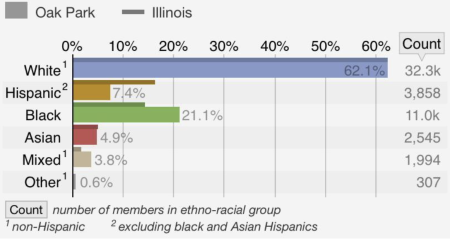Adapted from Just Action (Rothstein and Rothstein, 2023)
by Monica Li
Integration interventions in Oak Park, Illinois, as listed below, have seen success in the change of its racial composition from 1% Black American in 1970 to 22% in 2000 and 2010.
- Residents adopted a diversity statement in 1973 stating, “Oak Park has committed itself to equality not only because it is legal, but because it is right; not only because equality is ethical, but because it is desirable for us and our children…” (p. 226, Just Action).
- The people of Oak Park advocated for racial integration despite some authority figures and realtors who insisted on continued segregation.
- Oak Park had housing options for various income levels, and it also had a municipal government, which made integration advocacy more centralized and effective.
- Efforts were dedicated towards apartment integration and not just homeownership.
- Officials with integration goals were elected to play a role in ensuring fair housing, prohibiting “for sale” signs on lawns that induce speculative panic, creating a no-solicitation list, and supporting integration within school systems.
- To prevent White flight, a home-equity insurance program was created to provide insurance against property value declines, which undercut realtor influences and secured White homeownership, while Black homebuyers progress into the neighborhood.
Overall, Oak Park came to its success by bringing attention to its rental market, getting support from its local government, and being naturally race-conscious in its efforts. There are now 40% of blacks who own their homes and 60% who rent in Oak Park. In contrast, 60% of White Oak Park residents own their homes, while 40% rent.
Recent ethnic-racial composition of Oak Park, Illinois1
Chart adapted from http://statisticalatlas.com/
References
1 Overview of the United States. The Demographic Statistical Atlas of the United States – Statistical Atlas. (n.d.). http://statisticalatlas.com/
2Rothstein, R., & Rothstein, L. (2023). Just action: How to challenge segregation enacted under the color of law. Liveright Publishing Corporation, a division of W.W. Norton & Company.


